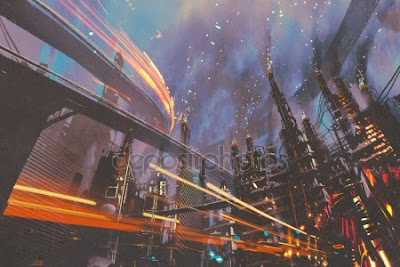Before creating the storyboard, I decided to conduct research on cool shots that I could use in the film opening. I began by watchingYouTube videos on classic sci-fi films. When going through videos, I stumbled upon a YouTube channel named Cinefix. They post "top 10" lists in which they discuss the best films openings, adaptations, stunts, and other features of films. Some of the videos I watched from their channel include: "Top Ten Science Fiction Films of All Time", "Why Does Science Fiction Love Dystopias?", and "Top Ten Sci-Fi Movies That Will Become Classics."
From these videos I learned a lot, but mostly I caught the repeated themes seen in sci- fi films. For example, the film is either set in the past or future, which is most of the time in a dystopian world. This world Then a major problem arises that most often has to do with the advancement of technology, an alien species, or a foreign disease attacking the world. The reason these themes are seen quite often is because the genre tackles all forms of speculation and paranoia. The genre addresses issues that people fear would happen, but seem near impossible. However, each film has some element that makes it unique from others, which is why although many films have the same theme, the films don't seem repetitive.
Another video of their's I watched was "Best Shots of All Time." I kept in mind that these lists are created based on opinion, however the channel has almost 4 million subscribers and receives lots of support from filmmakers. Therefore, I do believe their opinion is significant and it's good to take into account what they believe are the best shots. Not to mention, they also listen to their subscribers feedback left in the comments to improve their next parts of this series. They were able to choose the best shots based on: angles, subject relationships, movement, purpose, and size.
Alien (1979)
I learned that to introduce my main character, I would most likely use a close-up because this shot allows me to show the emotion the character feels, in an intimate way. I could combine a close-up and point of view shot right in the beginning of the opening to immediately place the viewer in the story. In doing this, the viewer would feel the same way the main character does because of the situation they're placed in. Like the shot in "Alien" with the close-up of the astronauts face as he views space. From this shot you can see the astonishment the astronaut feels.
Schindler's List (1993)
Then there's the long shot, meant to show the whole body and what it's doing. In this shot, the attention is no longer just on the face of the character, but on the character's movement or distance from another character. This conveys the relationship between two characters, or how the character acts in a specific environment. Like the shot in Schindler's list in which Schindler stands talking to another character in front of a burning mountain. Here, the attention is placed on more than just one sole character.
Most of the scenes featured in this video consisted of close-ups and long shots. These are two basic shots but when used the right way, they can show the character's emotions and environment without the use of any dialogue.
In order to complete one of the tasks on my checklist, which is to do research on technologies used in sci-fi films, I will watch another video I found on the same channel that features the best tech innovations that are seen in sci-fi films. Hopefully, this video inspires me to come up with what I want the implant to look like. Since I can't actually create a new technology, it will only be used as a prop for the film, however I want it to look as realistic as possible. If I make it a small device that is within the character's skin, then I don't have to worry much about the looks of it, I can just focus on using makeup to create the design on the character's arm. However, if it is on the exterior part of the arm, then I need to design a small shape that looks like a new form of technology to the viewer.
I have so much to think about! Ok I'll be back soon with updates.
























